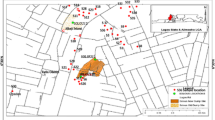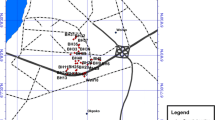Abstract
Automobile junk waste in Obosi and residence in housing estate in Anambra State, Southeast Nigeria, was studied for concern for human health. There is poor water quality for drinking, domestic and irrigation purposes. A seasonal study was conducted in the area for hydrogeochemical and microbial assessment for groundwater. To evaluate the release of the potentially toxic elements, 40 groundwater sources (borehole and hand-dug wells) were sampled. The groundwater was subjected to atomic absorption spectrometry and microbial methods. Particle size distributions for grain size analyses (for permeability) on the soils were conducted as a follow-up from previous study. Results show that the groundwater in the wet season (as a follow-up from dry season) is slightly acidic to neutral (6.04 to 6.54) when compared with the regulatory standards for drinking water. The heavy metal concentrations (in mg/L) in the groundwater included iron, chromium, zinc, nickel and lead that ranged from 0 to 0.73, 0 to 0.67, 0.52 to 6.45, 0 to 0.92 and 0 to 0.25 respectively. The microbial analysis in the groundwater recorded absent of faecal and lower counts of coliform (NTU) that ranged from 1.0 × 102 to 2.5 × 103 cfu/mL. The permeability K (in cm/s) is rated medium across the soils and ranged from 2.25 × 10−2 to 4.41 × 10−2. Geochemical thermodynamic modelling (PHREEQC) predicts iron oxyhydroxide phases as responsible minerals precipitating in the system. Paired t test showed no significant difference on iron and nickel at wet and dry seasons while other heavy metals are statistically significant.

















Similar content being viewed by others
Data availability
The data that supported the findings of this study are available from the authors upon request.
Code availability
Not applicable.
References
Adamu CI, Nganje TN, Edet A (2015) Heavy metal contamination and health risk assessment associated with abandoned barite mines in Cross River State, southeastern Nigeria. Environ Nanotechnol Monit Manag 3:10–21
Amajor LC (1991) Aquifers in the benin formation (miocene – recent) eastern niger delta, Nigeria. Lithostratigraphy, hydrualic and water quality. Environ Geol Water Sci 17(2):85–101
Ameh P, Igwe O, Abdullateef L, Mustapha A, Isa A, Zakariyau KK (2018) Assessment of the implications of geotechnical properties of soils in Otukpa area of Ogbadibo LGA, Benue State, Nigeria. J Geosci Geomat 6(1):1–11. https://doi.org/10.12691/jgg-6-1-1
APHA (2005) American Public Health Association, Standard methods for the examination of water and wastewater. 21st ed. Washington, D. C.
Appelo CAJ, Postma D (1994) Geochemistry, groundwater and pollution. A.A. Balkema, Rotterdam
Arinze IE, Igwe O, Una CO (2015) Analysis of heavy metals’ contamination in soils and water at automobile junk markets in Obosi and Nnewi, Anambra State, Southeastern Nigeria. Arab J Geosci. https://doi.org/10.1007/s12517-015-2001-6
ASTM D6913-04 (2009) Standard test method for particle size distribution (gradation) of soil using sieve analysis.
Awachie JB, Ezenwaji H (1981) The fisheries development of the Anambra River Basin, Nigeria. CIFA Technical paper 8: 212 - 224.
Banks D, Younger PL, Dumpleton S (1996) The historical use of mine-drainage and pyrite-oxidation waters in central and eastern England, United Kingdom. Hydrogeol J 4(4):55–68
Behzad M, Shiva M, Behrouz R, Behrouz Y (2015) Assessment of metal contamination in groundwater and soils in the Ahangaran mining district, West of Iran. J Environ Monit Assess 187:727
Deutsch WJ (1997) Groundwater geochemistry: fundamentals and application to contamination. CRC, Boca Raton
Franson MAH (1975) Standard methods for the examination of water and wastewater. APHA-AWWA-WPCF.
Freeze RA, Cherry JA (1979) Groundwater. Prentice-Hall International, Englewood Cliffs, pp 80–462 ISBN 0-13-365312-9
Gundersen P, Steinnes E (2001) Influence of temporal variations in river discharge, pH, alkalinity and Ca on the speciation and concentration of heavy metals in some mining polluted rivers. Aquat Geochem 7:173–193
Hazen A (1983) Some physical properties of sands and gravels. Mass State Board Health, 24th Annual Report.
Igwe O, Chukwura UO (2018) Integrated physicochemical and hydrogeochemical assessment to groundwater quality in Obosi and Onitsha provinces, South-eastern Nigeria. Environ Earth Sci 77:263. https://doi.org/10.1007/s12665-018-7433-3
Iloeje NP (1965) A new geography of Nigeria. Longmans of Nigeria, Ikeja 221p
Keller EA (2008) Introduction to environmental geology 4th edition. Pearson International Publisher, pp. 367 – 370.
Khodapanah I, Sulaiman WNA, Khodapanah N (2009) Groundwater quality assessment for different purposes in Eshtehard District Tehran—Iran. Eur J Sci Res 36(4):543–553
Kříbek B, Zachariáš J, Knésl I, Míková J, Mihaljevič M, Veselovský F, Bamba O (2016) Geochemistry, mineralogy, and isotope composition of Pb, Zn, and Cu in primary ores, gossan and barren ferruginous crust from the Perkoa base metal deposit, Burkina Faso. J Geochem Explor 168:49–64
Langmuir D (1997) Aqueous environmental geochemistry. Prentice Hall, California
Markiewicz-Patkowska J, Hursthouse A, Przybyla-Kij H (2005) The interaction of heavy metals with urban soils: sorption behaviour of Cd, Cu, Cr, Pb and Zn with a typical mixed brownfield deposit. Environ Int 31(4):513–521
Mielke HW, Gonzales CR, Smith MK, Mielke PW (1999) The urban environment and children’s health: soils as an integrator of lead, zinc, and cadmium in New Orleans, Louisiana, U.S.A. Environ Res 81(2):117–129
Nfor BN, Olobaniyi SB, Ogala JE (2007) Extent and distribution of groundwater resources in parts of Anambra State, Southeastern, Nigeria. J Appl Sci Environ Manag 11(2):215–221
Nishida H, Miyai F, Tada F, Suzuk F (1982) Computations of index of pollution caused by heavy metals in river sediments. Environ Pollut Ser B 4:241–248
NSDWQ (2007) Nigerian Standard for Drinking Water Quality. Nigeria Ind Stand, NIS 554:13–14
Nwajide CS (2013) Geology of Nigeria sedimentary basins. CSS Bookshop, Awka, pp 277–384
Parkhurst DL, Appelo CAJ (1999) User’s guide to PHREEQC (version 2)—a computer program for speciation batch-reaction, one dimensional transport and inverse geochemical calculations, 99 – 4259.
Reyment R A (1965) Aspects of the geology of Nigeria. University of Ibadan, Nigeria Press. p. 133
Singh M, Muller G, Singh IB (2002) Heavy metals in freshly deposited stream sediment of rivers associated with urbanization of the Ganga Plain, India. Water Air Soil Pollut 141:35–54
Smith MN, Ali S, Bofinger C, Collins N (2016) Human health and safety in artisanal and small-scale mining: an integrated approach to risk mitigation. J Clean Prod 129:43–52
Sundaray SK, Nayak BB, Lin S, Bhatta D (2011) Geochemical speciation and risk assessment of heavy metals in the river estuarine sediments—a case study: Mahanadi Basin, India. J Hazard Mater 186:1837–1846
Terzaghi K, Peck RB (1967) Soil mechanics in Engineering practice, 2nd edn. Wiley, New York
Wei B, Yang L (2010) A review of heavy metal contaminations in urban soils, urban road dusts and agricultural soils from China. Microchem J 94(2):99–107
Wenfeng T, Fan L, Xionghan F, Qiaoyun H, Xueyuan L (2005) Adsorption and redox reactions of heavy metals on Fe–Mn nodules from Chinese soils. J Colloid Interface Sci 284:600–605
WHO (1989) Environmental Health Criteria 3 and 5 CPCB (1997). CPCB News letter 4(iii)
WHO (2009) Water for pharmaceutical use, in quality assurance of pharmaceuticals: a compendium of guidelines and related materials, 2nd edn. World Health Organization, Geneva
WHO (2011) Guidelines for drinking water quality. World Health Organisation, Geneva
Wilcox LV (1955) Classification and use of irrigation waters. US department of agriculture circular 96919.
Yuce G, Pinarbasi A, Ozcelik S, Ugurluoglu D (2006) Soil and water pollution derived from anthropogenic activities in the Porsuk River Basin, Turkey. Environ Geol 49(3):359–375
Acknowledgements
The field work of this study is self funded. The authors wishes to express their profound gratitude to post-graduate student Okey Chukwura for assisting in the field, and the staff of the laboratories of the Energy Centre and Geology department in the University of Nigeria, Nsukka Campus, for assisting in the laboratory. Appreciation also goes to Peter Nzoiwu for the support with the Statistical modelling tool. Proof-reader, Mr Nnaemeka Osoagba. We are also grateful to the anonymous reviewers for aiding to shape the final manuscript.
Funding
The research work is self-funded from the corresponding author’s PhD project.
Author information
Authors and Affiliations
Contributions
All authors contributed to the study concept and design. Material preparation, data collection and analysis were performed by Uche O. Chukwura and assisted by post-graduate student Okey Chukwura and staff of the Energy Centre and Geology sieve analysis laboratories in the University of Nigeria, Nsukka Campus, under the supervision of Ogbonnaya Igwe. The first draft of the manuscript was written by Uche O. Chukwura and all authors commented on previous versions of the manuscript. All authors read and approved the final manuscript.
Corresponding author
Ethics declarations
Conflict of interest
The authors declare no competing interests.
Additional information
Responsible Editor: Broder J. Merkel
Rights and permissions
About this article
Cite this article
Chukwura, U.O., Igwe, O. Seasonal evaluation of the hydrogeochemical interpretations of groundwater quality: a case study from automobile junk waste in Obosi and Onitsha environs, Southeast Nigeria. Arab J Geosci 14, 244 (2021). https://doi.org/10.1007/s12517-021-06643-0
Received:
Accepted:
Published:
DOI: https://doi.org/10.1007/s12517-021-06643-0




